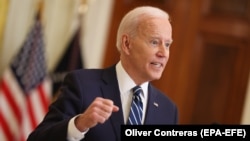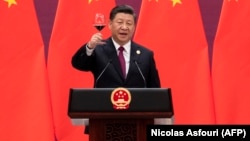
Welcome back to the China In Eurasia briefing, an RFE/RL newsletter tracking China’s resurgent influence from Eastern Europe to Central Asia.
As you may have heard, the China In Eurasia newsletter will now be going out twice a month. Expect to see it in your inbox on the first and third Wednesdays of each month. I’m RFE/RL correspondent Reid Standish and here’s what I’m following right now.
In Search Of A Western Belt And Road
Growing disillusionment with the Belt and Road Initiative (BRI), China’s massive infrastructure project, has opened the door for an alternative to emerge. Ahead of next month’s Group of Seven (G7) summit, discussion within the group is heating up around how to rival Beijing’s signature policy.
Finding Perspective: U.S. President Joe Biden proposed the idea of setting up a Western-led infrastructure plan that would rival China’s flagship BRI back in March to British Prime Minister Boris Johnson, and the idea continues to progress.
China will feature prominently on the agenda of the June 11-13 summit, which will bring together the traditional group of Canada, France, Germany, Italy, Japan, the United Kingdom, and the United States, plus representatives from Australia, India, and South Korea.
Coming up with an alternative is no easy feat, as I reported earlier.
Finding consensus among multiple countries, each with different economic and political realities, plus balancing public versus private funding concerns, are major obstacles to developing any plan.
Beijing has leveraged its state-backed approach to its advantage. Since it was announced in 2013, the BRI has channeled hundreds of billions of dollars into foreign infrastructure and has been supported by international organizations and more than 150 countries.
But rising buyer’s remorse over stalled projects and growing unease over the strategic implications of the BRI now have the idea of a Western-led alternative on the table leading into the G7 summit.
Why It Matters: The reality is that any plan will likely be a patchwork of coordinated initiatives rather than a true, unified Western alternative.
This also isn’t the first time that such discussions have materialized. Both the European Union and the United States have launched infrastructure initiatives in recent years that haven’t yielded concrete results.
Heading into the G7, many analysts are unsure if the West should try to directly rival the BRI in terms of dollars and total investments or instead pinpoint strategic industries, especially anything around next-generation tech.
It still remains to be seen how things will shake out. But the West has many advantages it can offer, and the current moment of hardening attitudes toward China around the world presents an opportunity.
Read More
- “Political interest around this is moving, but actually pulling an alternative together and showing what it looks like is not developed yet,” Andrew Small, a fellow with the German Marshall Fund in Berlin, told me about the current discussions leading up to the G7 summit.
- Global demand hasn’t been met. The world’s infrastructure needs are estimated at $94 trillion over the next two decades. Current trends show $79 trillion in investment coming in, leaving a $15 trillion gap that more Western initiatives could help fill.
Expert Corner: Competing With Beijing On Infrastructure
Readers asked: “How substantial are talks to come up with a Western answer to the Belt and Road?”
To find out more, I asked Reinhard Buetikofer, a German politician and the chair of the European Parliament’s delegation for relations with China.
"The current discussions are very serious. In the EU, the parliament has adopted a global connectivity strategy and connectivity financing has been included in the programming of the [Neighborhood, Development and International Cooperation Instrument], the EU's global financing instrument. President Biden has highlighted the issue. India, Japan, Australia, ASEAN, and other partners are highly interested in moving the connectivity agenda forward.
"China has been exploiting the needs of developing countries, but lamenting about that fact without offering an alternative is useless. You cannot fight something with nothing. The difference between Western connectivity strategy and China's BRI will be threefold: We will insist on high-quality and high-standard projects; we will avoid debt traps; we will mobilize private-sector involvement to strengthen our initiatives."
Do you have a question about China’s growing footprint in Eurasia? Send it to me at StandishR@rferl.org or reply directly to this e-mail and I’ll get it answered by leading experts and policymakers.
Three More Stories From Eurasia
1. An Eye On Central Asia
China held its second-annual summit with Central Asia’s foreign ministers on May 11-12, where Beijing placed itself at the center of the region’s post-pandemic recovery.
Planning Ahead: The summit produced a mix of promises and deliverables for the five Central Asian states -- Kazakhstan, Kyrgyzstan, Tajikistan, Turkmenistan, and Uzbekistan -- by discussing plans for a 30-year cooperation agreement with the region and outlining some future investments in the agriculture industry.
But as my colleagues Marat Tagaev and Kubat Kasymbekov from RFE/RL Kyrgyz Service reported, Beijing used the summit to put Kyrgyzstan in the spotlight.
China waived any late fees or interest payments for future debt deferment (Kyrgyzstan owes about $1.8 billion to the Export-Import Bank of China), and Beijing also granted Bishkek food aid and other funds to help with the recovery from the recent border violence between Kyrgyzstan and Tajikistan.
Beijing also pressed Bishkek to move forward with the planned China-Kyrgyzstan-Uzbekistan railway, which has faced multiple setbacks on the Kyrgyz side. (For more background, read this piece by my colleague Bruce Pannier.)
The Big Picture: Beijing continues to position itself at the heart of the region and is strategically using its main asset -- its pocketbook -- to deepen its sway among its neighbors.
It also points to China’s increasing use of bilateral and multilateral methods to engage with the region outside of formats that also include Russia, such as the Shanghai Cooperation Organization (SCO).
2. Fast Times At Fudan’s Budapest Campus
A new executive order passed by the Hungarian government will now make it difficult for the municipal government in Budapest to stop plans for the construction of a Fudan University campus in the city, RFE/RL’s Hungarian Service reported.
Sealing The Deal: Budapest Mayor Gergely Karacsony told my colleague Akos Keller-Alant and me earlier this month that he planned to oppose construction of the controversial Chinese university, but the new legislation seems to tie his hands by allowing the government to bypass the municipal authorities.
The campus, planned for 2024, is controversial because the Hungarian government aims to take out a $1.5 billion loan from a Chinese bank to cover the majority of the costs for the university.
The first Chinese university in the EU will also be built at a site that was previously allocated for affordable housing for Hungarian students.
For a quick explainer on the situation, watch this RFE/RL video.
Deeper Connections: The Hungarian investigative journalism outlet Direkt36 also reported new details around the Chinese campus, with Chinese Foreign Minister Wang Yi telling Hungarian politicians in 2019 that the university was a “top priority” for Beijing.
According to their report, professors at the university will earn an extremely generous $250,000 annual salary, compared to the average professor’s salary of $22,000. This adds to growing concerns that the Chinese campus will drain both financial and human capital away from Hungary’s education system.
3. Still In Session
While China’s entry into Hungary’s higher-education system sparks controversy over academic freedom and a lack of transparency, Beijing continues to deepen its influence in neighboring Serbia’s universities.
A Closer Look: As I reported with my colleagues Ljudmila Cvetkovic and Maja Zivanovic from RFE/RL’s Balkan Service, three Serbian universities have signed a cooperation agreement with Shanghai's Jiao Tong University, opening the door to deepening educational and cultural bonds between Serbia and China.
Belgrade has close ties to Beijing, with observers saying that Serbia functions as a showcase in the region for Chinese initiatives and an example for the merits of close cooperation.
China’s ties to education in the country are also beginning to expand beyond higher education and are part of a new phase of Chinese engagement across the Balkans that has a growing cultural focus.
Across The Supercontinent
Damage Control: In addition to debt concerns, Montenegro’s billion-dollar highway is also in the crosshairs for environmental damage that construction has brought to the UNESCO-protected Tara River, my colleagues Bojana Moskov, Predrag Tomovic, and Andy Heil reported.
The Xinjiang Picket: Small but sustained protests outside the Chinese Consulate in Almaty, Kazakhstan’s largest city, have continued for 100 days, RFE/RL’s Kazakh Service reported.
Protesters are demanding the release of their relatives detained in neighboring Xinjiang, where Beijing has run an internment camp system for Uyghurs and other Muslim minorities.
Pick Your Shot: Former Kyrgyz Prime Minister and political heavy hitter Omurbek Babanov publicly took China’s Sinopharm vaccine.
Kyrgyzstan is relying on a mix of the World Health Organization’s COVAX program and doses of Russia’s Sputnik V, but shipments of both are running behind. Earlier this spring, China donated 150,000 shots of its Sinopharm vaccine to its Central Asian neighbor.
The Diaspora: RFE/RL’s Ukrainian Service has a deep look at Ukraine’s small but growing Chinese community, looking at the cultural and financial ties that are forming, as well as how Beijing views its citizens abroad.
The 'Uber Killer': The Chinese ride-sharing app DiDi -- known as China’s “Uber killer” for its ability to undercut its competition -- will launch in Kazakhstan this summer as part of a wider expansion across the region.
One Thing To Watch
Germany’s Free Democratic Party (FDP) voted to drop support for a “one China policy” in its election program.
The move is part of some wider shifts taking place across Germany’s political spectrum with respect to China ahead of elections in September that will mark the end of Chancellor Angela Merkel’s long tenure.
The Greens' candidate for chancellor, Annalena Baerbock, who could potentially come to power through a coalition government in September, has also vowed to get tough on China.
Any shifts toward Beijing that result from the German elections will have ripple effects across Europe and beyond, with many countries taking their foreign policy cues from the EU’s largest economy.
That’s all from me for now. Don’t forget to send me any questions, comments, or tips that you might have.
If you enjoyed this briefing and don't want to miss the next edition, subscribe here. It will be sent to your in-box on the first and third Wednesdays of each month.









